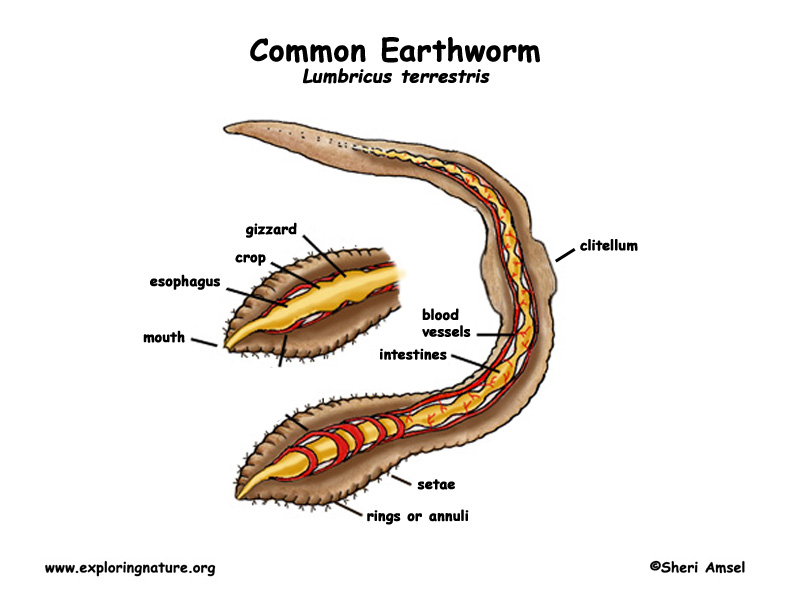

They may have first come from Europe, but earthworms have been brought by people all over the world.
They live in moist soil under grasslands and forests.
They are 7-10 inches long (20-25cm) and pinkish-tan in color on top and lighter underneath. They are mostly round with a flatter end and rings or segments their whole length, called annuli. Each segment has little, stiff hairs called setae that help the earthworm move through the soil. They have no lungs, but breathe through their skin. They need moist soil for this, but not too wet or they can’t get to the oxygen in the soil. In heavy rainfall they often come to the surface to breathe. They cannot stay on the surface for long though because they are sensitive to sunlight and will die. This is why they usually only come to the surface at night, where they can be seen mating. They have a thicker area called the clitellum, that makes the cocoon where young develop. They have no teeth but gather food in the crop and grind it up in the gizzard.
They mix up the soil by bringing organic matter (like leaves and rotting things) down into their burrows from the surface. This helps add air to the soil making earthworms good for their habitat. Their waste is called castings and also helps the soil.
They eat organic matter (leaves and other rotting plant or animal matter). They pull the matter into their mouths and it moves down into their crop where it is stored for short periods of time. Then, because earthworms have no teeth, the food goes into the gizzard where it is ground up. Then it moves onto the intestines where it is broken down and absorbed into the blood.
They are eaten by birds, amphibians, reptiles, some mammals and harvested by man.
Earthworms have both male and female parts (hermaphrodites), but they still must mate with another worm. They come to the surface at night to mate. Fertilized eggs are left in a cocoon made by the clitellum to develop.
Kingdom: Animalia
Phylum: Annelida
Class: Clitellata
Subclass: Oligochaeta
Order: Haplotaxida
Family: Lumbricidae
Genus: Lumbricus
Species: L. terrestris
When you research information you must cite the reference. Citing for websites is different from citing from books, magazines and periodicals. The style of citing shown here is from the MLA Style Citations (Modern Language Association).
When citing a WEBSITE the general format is as follows.
Author Last Name, First Name(s). "Title: Subtitle of Part of Web Page, if appropriate." Title: Subtitle: Section of Page if appropriate. Sponsoring/Publishing Agency, If Given. Additional significant descriptive information. Date of Electronic Publication or other Date, such as Last Updated. Day Month Year of access < URL >.
Amsel, Sheri. "Earthworm (Common)" Exploring Nature Educational Resource ©2005-2024. December 14, 2024
< http://www.exploringnature.org/db/view/Earthworm-Common >

